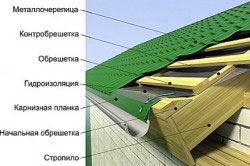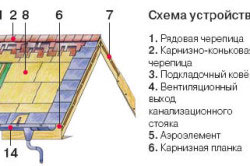A good roof is an architecturally attractive, reliable, technically equipped and durable structure. This is the kind of roof that home owners who are building or renovating want to create. In this case, the question of what to make the roof of the house, each person decides in different ways. In this article, we will describe the most important rules regarding this issue.
The guarantee of reliability
Choice roofing for the roof is always a second thought and a reason to assess their financial capabilities. What to choose?
Modern roll materials or slate slate? Ondulin or professional flooring? or natural tiles?
Suffering over this issue, many homeowners reduce their attention to the issue of the foundation of the roof. What will the selected material fit on?
In other words, the quality of the coating is not the main determining factor in the reliability of the roof.
The strength and durability of the roof is due to two factors:
- quality rafter system (grounds);
- quality of roofing material.
Roof base
If you do not initially take care of the strength of the base structure, it is unlikely that you will be able to equip a good roof. The evidence for this fact lies on the surface: over time, the rafter system, which is not designed for the load, will simply begin to break.
Attention. Keep in mind that the rafters are designed to absorb the weight of the roofing, strong winds and snow pressure.
Therefore, when choosing materials for the truss system, it is necessary to consider:
- type and weight of the roof covering;
- weather conditions typical for a certain area;
- the thickness of the snow masses;
- wind strength;
- additional safety margin.
Only strong roof rafters can provide adequate protection to a building structure. However, you should not prepare the foundation as if the roof is ready to resist under the aircraft shells.
Council. This business requires meticulous planning and optimal solutions.
When choosing a material, both for the roof and for the rafters, keep in mind that the house is a complete system. If the supporting structure of the roof is able to withstand the roofing, then the supports - the walls, must correspond to the loads of the two links - the covering and the rafters.
Walls, as a rule, also do not adhere to air. Accordingly, the foundation of the house must withstand the entire above-ground structure.
However, this is an abstract attitude to the issue, which, in fact, is the topic of our article. We think you will find more accurate recommendations useful.
Primary requirements
According to the existing SNIP, the calculation of the roof structure provides for withstanding a load of 200 kg per 1 sq. m, regardless of the severity of the roofing.
This indicator includes an additional strength factor, wind and snow load.
Additional stock is applicable based on:
- hurricane wind;
- multi-day snowfall;
- the presence of repairmen on the surface of the roof, for the maintenance of the roof covering.
The main calculation is based on the features of the roofing material laid on the rafters.
Rafter material
What is the best way to make the roof of the house, that is, the rafter structure? At the moment, wooden rafters are in demand in construction, which is due to the excellent quality of wood.
Many may argue that wooden structure not as strong and durable as, for example, reinforced concrete or metal.
In this regard, it can be noted: in order to lift heavy reinforced concrete rafters to the roof, it is necessary to attract special equipment. The next moment. Imagine if mistakes were made during the construction of the walls.
As is usually the case, the rafters need to be adjusted. When using metal or concrete, this is extremely difficult or almost impossible.
And, finally, lay the roofing material according to wooden base much easier than on the described alternative basis.
That is why heavy metal constructions used on large construction sites with complex roof configurations.
Wooden rafters are manufactured and lifted without the use of hoisting machines.
In addition, they can be customized without much effort:
- shorten;
- ramp up.
Naturally, various roofing materials make adjustments to the wooden truss structure. If a heavy roof is used, then the rafters must also be strong enough; with light roofing materials, a lightweight rafter system can be used.
This is regulated by the norms of SNIP and the desire of home owners to save on construction.
The most optimal dimensions for the manufacture of rafters:
- with a heavy roof, the rafter section should be more than 70x150 mm with a minimum pitch;
- for a light covering for rafters, a piece of wood 50x150 mm is used in increments of up to one meter.
As the roof slope increases, the pitch increases.
Lathing material
But, the base is not formed from some rafters. For laying the roofing material, it is necessary to build a crate. It is best to use dried wood for its manufacture so that the roof does not deform.
For example, for roll roofing or soft tiles, a flooring made of waterproof plywood or thin boards acts as a sheathing. Bars 60x60 mm are taken under natural or metal tiles. Therefore, the type of lathing is determined by the type of roofing material.
The choice of roofing material
The influence of atmospheric precipitation, sudden temperature changes, mechanical stress can be reduced by the correct selection of roofing materials. To determine what is better to make a roof, it is necessary to conditionally divide the roof into:
- heavy;
- easy.
If the weight of the roof covering is 5kg per sq. m, then the roof is considered to be light.
- professional flooring;
- soft bituminous coating.
When using such a coating, the roof is installed quickly; the roof structure itself is light, which reduces the load on the walls and foundation; the cost of the roof is relatively cheap.
In addition, the roof can be easily disassembled when it is necessary to replace parts of the covering or supporting structure. Based on a survey of consumers on the question of which material is better to cover the roof, first of all, the following roofing coatings can be noted:
- soft tiles.
The popularity of metal tiles
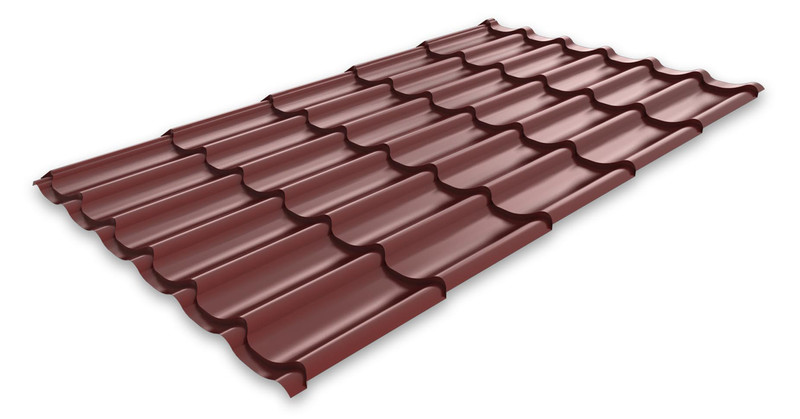
Metal tile
The metal tile is based on galvanized steel. A special coating is applied on both sides.
This material has long been among the popular among many roofing materials. The reason for this popularity is due to a number of advantages of this design, as well as its appearance.
The advantages of metal tiles include:
- high resistance to corrosion, subject to correct transportation and installation;
- light weight;
- ease of coating device;
- lightweight version of the rafter system;
- ease of roof repair;
- operational period up to 30 years;
- variety of shades and colors.
However, giving preference to this material, it should be borne in mind that during its construction it is necessary to arrange noise insulation, thermal insulation, waterproofing, lightning rod. The service life of metal tiles, color fastness and performance characteristics of the material are affected by its polymer coating.
There are several types of coverage;
- plastisol;
- polyester;
- pural;
- matt polyester.
The polyester coating is characterized by:
- optimal ratio of quality and cost;
- good color fastness;
- the possibility of using in various climatic conditions.
Matte polyester has the same benefits as a regular finish, only it has a nicer look.
Puralova coating is resistant to chemical attack, solar radiation, high temperature, has a silky surface. The plastisol coating is resistant to mechanical stress and weathering. However, the resistance to solar radiation is poor.
Council. Therefore, plastisol-coated metal tiles are not recommended for roofing in southern regions.
Although, in an aggressive environment corrosion-resistant plastisol.
Types of soft roof

Expressed by the need to build a solid foundation.
Soft roofing is divided into two types:
- piece;
- rolled.
Representatives roll materials are roofing material, rubemast, bikrost. Piece roofing materials include bituminous and soft tiles. A hard base must also be prepared for a soft roof.
The advantages of soft roofing include:
- preservation of shape during transportation and installation;
- ease, affordable price;
- installation speed.
Soft tiles has many colors, which allows you to diversify design solutions.
The main properties of a soft roof include its elasticity, which allows roofing on curved planes. Let be soft roof not as durable as roofing materials based on steel, but it has strength, reliability, frost resistance, and the ability to absorb noise.
Selection options
When choosing better material to cover the roof, several parameters should be followed:
- decorative qualities of the coating;
- material cost;
- weight and reliability of the roof.
If you want to avoid a heavy load on the supporting elements, then you need to choose a lighter material. For example, natural shingles are 10 times heavier than metal shingles, and 5 times heavier than flexible shingles.
The first thing to focus on when choosing the best material is its durability, practicality, appearance... The service life of the roof is affected by temperature changes. Porous roof coverings are especially susceptible to temperature influences.
Roof fire resistance is due to its composition. Soft tiles are not resistant to high temperatures, they are also easily flammable, since they contain bitumen. On the contrary, metal tiles are highly resistant to fire.
Over time, new technologies and materials appear on the construction market. We have described the most optimal choice in terms of quality and price, excluding those materials that are used in luxury construction.
In the process of building or renovating a house, the question usually arises, what is the best way to cover the roof?
In building a house important point is the roof and the material from which the roof will be installed.
Quite often, fashion influences the choice, but one should not forget that the main thing is that the material used must be of high quality.
The main parameters influencing the choice of material
The main criteria by which the choice of covering for the house is made are decorative qualities, reliability and cost. But the first thing that needs special attention is weight. When choosing a coating, it is necessary to take into account the load on bearing structures, that is, if the material is too heavy for them, then it is better to choose something easier.
Practicality and durability are equally important qualities of a future roof for a house. Usually, the service life of the material is indicated without taking into account the harsh operating conditions, so you need to build a roof that matches the climatic conditions of the region.
The cost of the roof is influenced by its thickness, which can provide good protection and an attractive appearance.
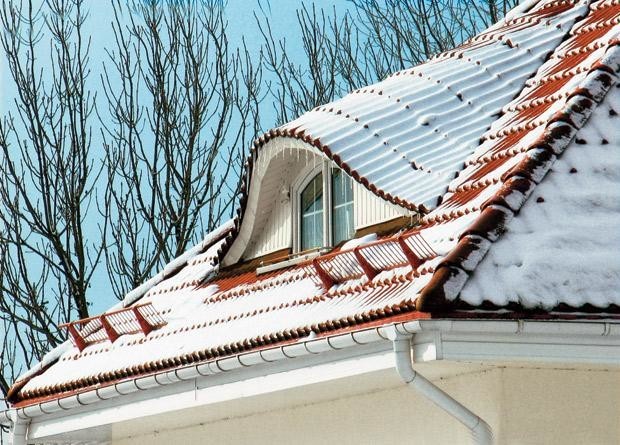
The basic principles on which almost everyone relies when choosing a material for the roof of a house are decorative qualities, reliability and cost.
Roofing material should be:
- resistant to UV rays;
- sealed;
- durable;
- resistant to temperature extremes and external influences;
- durable.
IN modern world there are approximately twenty types various materialsthat you can at home. However, exotic species are unlikely to be in high demand, so it is better to opt for popular and widespread roofing materials that are on the domestic construction market.
Slate sheets
Slate is presented in the form of large wavy sheets, which are made of asbestos-cement mortar. This material is durable, but it has a drawback - increased fragility. The standard sheet size is 1750 mm long, and the width varies from 980 to 1130 mm. Slate wave height - up to 54 mm.
Temperature drops do not have a destructive effect on the material, so if you cover the roof of your house with it, repair and replacement of the roof will not be needed for a long period of time. This is the most common option for covering most houses, since the material is low cost and neat.
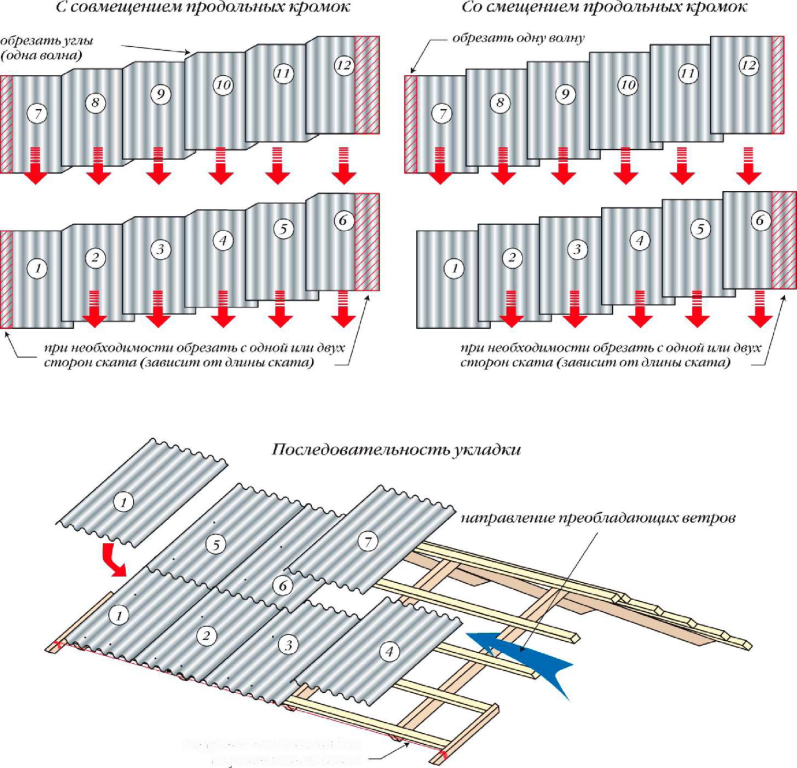
Layout of slate on the roof: with alignment, with offset of the longitudinal edges.
Installation of slate is quite simple, but it is necessary to work with it carefully so as not to damage the sheets, so there must be an assistant in the process. Or you can entrust the installation to professional craftsmen who will do everything efficiently and without damage. Modern slate covering is easy to paint in any shade, which will significantly improve the overall appearance of the roof and make it more durable. When choosing a slate, consider the following:
- sheets should be free of dents, cracks and various foreign inclusions;
- edge - to have an even appearance without delamination.
Ondulin - modern euro slate
The material is made by pressing cardboard, and after that it is treated with bitumen impregnation. Ondulin is often chosen as a future roof for residential buildings. It is able to serve for more than 30 years, has a relatively low price and is easy to install. This type of roof is an ideal solution for the construction of a beautiful and budgetary roof, which can be either single-pitched or gable. Ease of installation is provided by the lightness of the material, if, for example, compare it with slate.
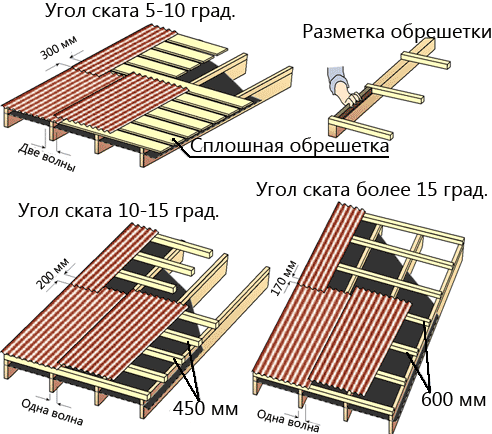
The main disadvantage of the material is its low strength and poor sound insulation. Therefore, during heavy rainfall, all the noise is clearly audible inside the house.
The construction material often counterfeited, therefore, its quality must be given special attention when choosing. Natural ondulin has the following features:
- on the inside has a corrugated mesh;
- a sheet of material consists of 10 waves;
- the outside is rough to the touch;
- the color is always matte and saturated;
- the code of the manufacturer's plant must be on the last wave of the sheet.
Metal sheets
This type of coating is usually made of aluminum or galvanized steel. Many people choose this material to cover the roof of the house because of its practicality and durability. It is not fragile, unlike slate, and at the same time has a low cost. One of the disadvantages is the complex installation process, the sheets are connected to each other using special folds or folds.
The advantages of this roofing material include:
- light weight;
- the coating can be used on sloping roofs and with a slight slope;
- long service life.
- weak insulation;
- poor protection from heat or cold.
Looks good as a roof and corrugated board made of steel sheet, on which a wavy or trapezoidal profile is formed. The sheet is treated with a polymer coating on both sides. This roof has high rigidity and low weight.
Beautiful metal tile
This type of roofing is created on the basis of galvanized steel and imitates shingles in its appearance. The material is treated with an anti-corrosion compound, so it can last for many years. - means to do right choice... The coating has several advantages:
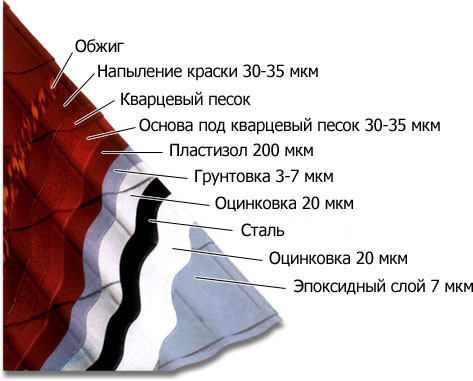
- ease of installation;
- it is reliable;
- perfectly decorates the house.
This material is made of metal, therefore, it has the same disadvantages as metal sheets.
The metal tile differs:
- by color (there are enough to choose from);
- waveform;
- type of coating (matte and glossy);
- thickness (from 0.4 to 0.5 mm);
- produced by various manufacturers.
Flexible or soft tiles
Such a tile is presented in the form of a multilayer material made on the basis of bitumen and metal-reinforced plastic. To give bitumen such properties as strength and resistance to deformation, special polymer compositions are added to it. Outside, the material is protected by a small basalt coating of various shades. Soft tiles are produced in the form of sheets standard size, usually 1m x 0.33mm.
Natural ceramic tiles
The material has been used to cover the roofs of houses for over a century and is made from fired clay. At the beginning, the clay blanks are shaped, dried and then fired in a special oven at a temperature of approximately 1000 ° C. Natural shingles have many advantages:

- durability (from 50 to 100 years);
- high resistance to humidity, ultraviolet radiation, frost or heat;
- ease of installation even on difficult surfaces due to the division into individual elements;
- environmental friendliness;
- good noise insulation;
- ceramic tiles is a prestigious and beautiful type of roof.
At the same time, the material is not devoid of certain disadvantages, which should also be noted:
- high cost, especially for glazed tiles;
- since the installation is done manually, this further increases the cost of the work if the installation is done by hired craftsmen;
- the elements of the tiles are quite heavy, so the supporting structures must be reliable;
- has a certain fragility, which manifests itself under increased mechanical stress.
Soft roll roof
The material is a multi-layer coating that protects the roof from negative impact various external factors, sharp temperature changes and precipitation. Although roll roofing is not an elite coating, it is quite popular and is often used during the construction of houses.
To decide whether to use this material, you need to consider all its advantages and disadvantages. The pluses include:
- strength and practicality;
- excellent hydro and sound insulation functions;
- fairly light weight;
- easy installation;
- high fire safety;
- resistance to temperature changes and UV rays;
- excellent degree of thermal protection;
- the material is made from environmentally friendly ingredients.
The main disadvantage of such a roof is the inability to ensure good tightness, which can lead to the accumulation of a large amount of water vapor in the middle of the insulation. Accordingly, at low temperatures, frozen water is capable of tearing the waterproofing layer from the base.
When building a private residential building, the choice of a roofing material that is suitable for the construction in terms of quality, appearance and cost is considered a rather urgent issue. In order to make the most correct choice, it is necessary to be guided by some parameters and characteristics that show the quality and relevance of this or that option for.
Modern roofing materials have high aesthetic qualities.
Features of the choice of materials
So, when choosing a roofing material, you should pay attention to:

The scheme of the roof structure made of corrugated board: 1 - corrugated board; 2 - lathing; 3 - ridge seal; 4 - skate; 5 - hydro and vapor barrier film; 6 - rafter leg (without counter-lattice); 7 - rafter leg; 8 - insulation; 9 - vapor barrier film; 10 - ceiling strip; 11 - lining, drywall.
- variety of forms;
- color ratio;
- the total weight of the roof, which must be taken into account during the construction of the load-bearing;
- cost of material and installation work;
- quality and reliability of roofing.
The weight of the roofing material plays a rather large role in the construction of the entire house, because the durability and reliability of the entire building depends on the correct distribution of the load on the supporting frame and the roof itself. It is for this reason that, before buying the right material for the roof, it is necessary to do all the required calculations that will determine the bearing capacity of the roof of the house.
The quality and service life of this or that option for the roofing system deserves special attention. For example, ceramic tiles can last for about 100 years, whereas a soft roof can become unusable in just 10 years, and it is important for us that the roof has served for many years.
Choice of type of structure and flooring
Each roofing system is designed to perform several functions of the basic type, each of which has rather important characteristics in any type of construction. First of all, it is worth considering the sound and thermal insulation of the building, protection from environmental influences and decorative function.
The choice of material for roofing
As a rule, the choice of the optimal roof covering, which can cover any roof, should be made by comparing the generally accepted factors. Such factors include the combination of the type and color of the roofing material with the facades of the house, the quality of the material, its cost and the possibility of repair work.
Considering all these factors, it is worth paying attention to the bituminous slate, which has all those characteristics and positions that can affect the choice of this material on the roof. First of all, it is worth recalling the plasticity and lightness of such slate, which has a positive effect on the installation and maintenance of the roof.
When a question arises about what is better in our time to cover private roof, it is worth remembering some tips and provisions, which will allow you to make the right choice. If the house does not differ in its large size and complex roofing structure, then it is better to cover the roof with bituminous slate or galvanized steel.
Private cottages are covered with a soft type roof or metal tiles, which makes it possible to give the building an attractive appearance, while not forgetting about all the positive characteristics of this roof. Complex roof structures that have bay windows and several ridges are best covered with a folded type roof, which is considered one of the most expensive.
Materials for outbuildings and technical buildings
A private house cannot do without household and technical buildings, which also need to be covered with one or another roofing deck. For such buildings, it is better to use a reliable and inexpensive material that will make the roof practical and cheap. These include simple slate, which has high quality characteristics and extremely low cost.
If such material does not fit well into the architectural design of a private courtyard, then the slate can be covered with a layer of a special dye composition, which, in addition to aesthetics, will give the roof additional protection from environmental influences.
Often, the roof of technical buildings is made of a flat type, which indicates the need to use a completely different type of roof. In such cases, corrugated board or soft-type roofing is used.
The first option is more reliable and durable, which is reflected in its cost, which, in turn, affects the state of the construction budget. The use of bitumen and roll roofing materials reduces the cost of construction, but increases the need to maintain such a roofing structure.
From all this, we can conclude that roofing material must be selected individually for each individual structure and building. Knowledge of all the characteristics and requirements for the roof allows you to make the most correct choice, having an acceptable ratio of cost and quality of the roof.

